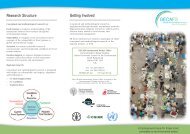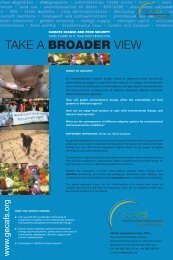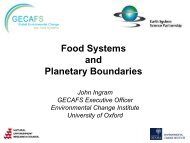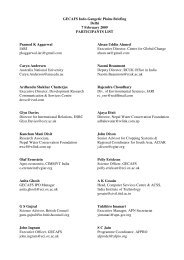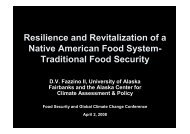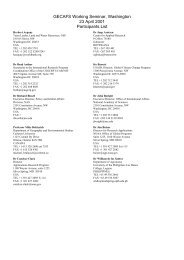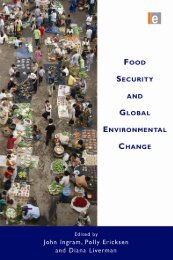From Food Production to Food Security - Global Environmental ...
From Food Production to Food Security - Global Environmental ...
From Food Production to Food Security - Global Environmental ...
- No tags were found...
Create successful ePaper yourself
Turn your PDF publications into a flip-book with our unique Google optimized e-Paper software.
Figure 3 Outcomes for 10 variables that collectively determine food security for four plausiblefutures for Caribbean food systems (reproduced from (Ingram and Izac, 2010), with permission). Arating of (++) indicates a high increase (i.e. outermost ring in the chart) and a rating of (+) <strong>to</strong> someincrease (i.e. the second outermost ring in the chart). Conversely, a rating of (- -) implies highdecrease (i.e. the innermost ring of the chart) and a rating of (-) reads as some decrease (i.e. thesecond innermost ring of the chart). Finally, a rating of (o) translates <strong>to</strong> no changes versus the currentsituation and a rating of (+/-) shows mixed trends with some increase in some aspects alongsidedecreases in others (i.e. both are depicted by a value on the ‘heavy line’ centre ring) (GECAFS,2006b).This CCAFS example highlights an important point about the framework: it serves as basethat can be further developed <strong>to</strong> be more useful and specific in a dynamic context, which canlead <strong>to</strong> a number of valuable research avenues. The framework is qualitative and morequantified analyses will be needed for many discussion-making processes. For instance, arange of models aimed at quantifying (as far as possible) the four food security elements isbeing identified by the CCAFS group with a view <strong>to</strong> ‘driving’ the axes of the spidergramsexemplified in Figure 3 (CCAFS Scenarios Team, 2010). The aim is <strong>to</strong> model how eachvariable (axis) evolves over time for each scenario, noting changes both within and betweendifferent scenarios, with a view <strong>to</strong> including the impact of technical and/or policyinterventions over time.These scenario exercises deliver a number of related outputs related <strong>to</strong> Figure 3: they provide(i) an analysis of all elements of food system outcomes (multiple axes on graphs); (ii) anassessment of how each outcome determinant would change (change of position along axes);46



